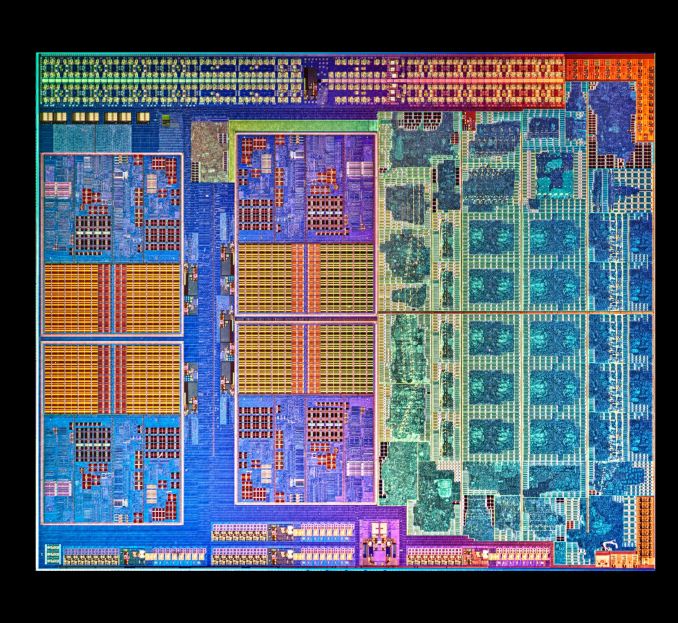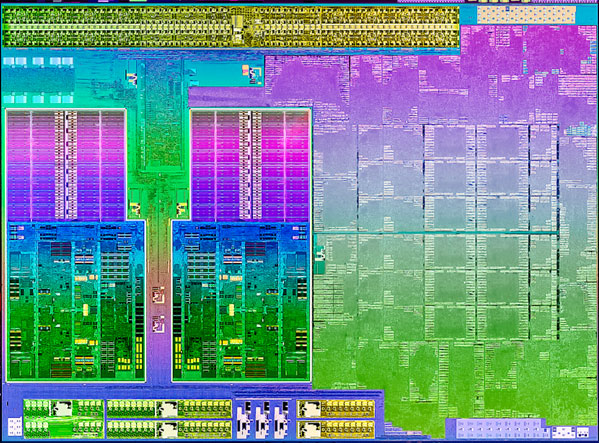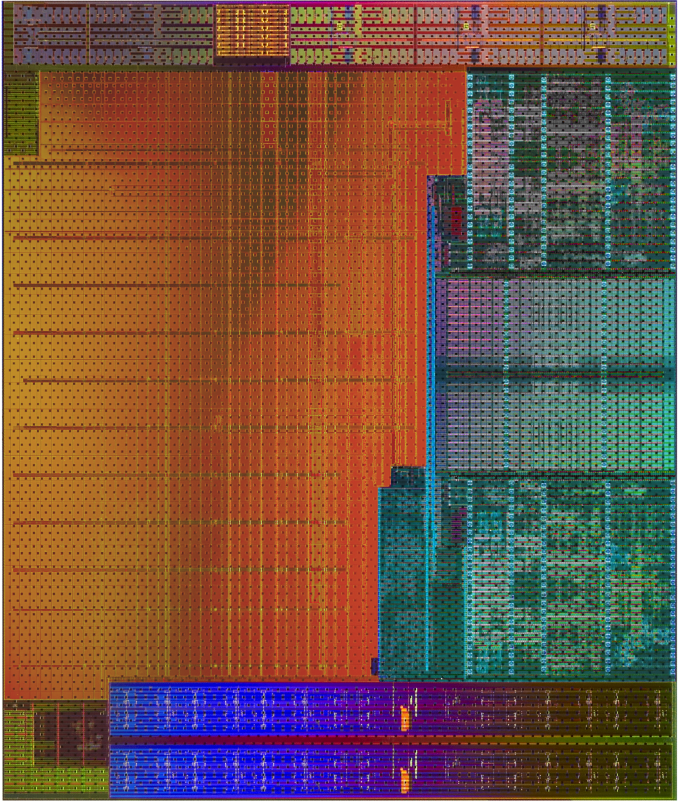AMD Kaveri Review: A8-7600 and A10-7850K Tested
by Ian Cutress & Rahul Garg on January 14, 2014 8:00 AM ESTLlano, Trinity and Kaveri Die: Compared
AMD sent along a high res shot of Kaveri's die. Armed with the same from the previous two generations, we can get a decent idea of the progression of AMD's APUs:
Llano, K10 Quad Core
Trinity and Richland Die, with two Piledriver modules and processor graphics
Kaveri, two modules and processor graphics
Moving from Llano to Trinity, we have the reduction from a fully-fledged quad core system to the dual module layout AMD is keeping with its APU range. Moving from Richland to Kaveri is actually a bigger step than one might imagine:
| AMD APU Details | ||||
| Core Name | Llano | Trinity | Richland | Kaveri |
| Microarch | K10 | Piledriver | Piledriver | Steamroller |
| CPU Example | A8-3850 | A10-5800K | A10-6800K | A10-7850K |
| Threads | 4 | 4 | 4 | 4 |
| Cores | 4 | 2 | 2 | 2 |
| GPU | HD 6550 | HD 7660D | HD 8670D | R7 |
| GPU Arch | VLIW5 | VLIW4 | VLIW4 | GCN 1.1 |
| GPU Cores | 400 | 384 | 384 | 512 |
| Die size / mm2 | 228 | 246 | 246 | 245 |
| Transistors | 1.178 B | 1.303 B | 1.303 B | 2.41 B |
| Power | 100W | 100W | 100W | 95W |
| CPU MHz | 2900 | 3800 | 4100 | 3700 |
| CPU Turbo | N/A | 4200 | 4400 | 4000 |
| L1 Cache |
256KB C$ 256KB D$ |
128KB C$ 64KB D$ |
128KB C$ 64KB D$ |
192KB C$ 64KB D$ |
| L2 Cache | 4 x 1MB | 2 x 2 MB | 2 x 2 MB | 2 x 2 MB |
| Node | 32nm SOI | 32nm SOI | 32nm SOI | 28nm SHP |
| Memory | DDR-1866 | DDR-1866 | DDR-2133 | DDR-2133 |
Looking back at Llano and Trinity/Richland, it's very clear that AMD's APUs on GF's 32nm SOI process had a real issue with transistor density. The table below attempts to put everything in perspective but keep in mind that, outside of Intel, no one does a good job of documenting how they are counting (estimating) transistors. My only hope is AMD's transistor counting methods are consistent across CPU and GPU, although that alone may be wishful thinking:
| Transistor Density Comparison | ||||||||
| Manufacturing Process | Transistor Count | Die Size | Transistors per mm2 | |||||
| AMD Kaveri | GF 28nm SHP | 2.41B | 245 mm2 | 9.837M | ||||
| AMD Richland | GF 32nm SOI | 1.30B | 246 mm2 | 5.285M | ||||
| AMD Llano | GF 32nm SOI | 1.178B | 228 mm2 | 5.166M | ||||
| AMD Bonaire (R7 260X) | TSMC 28nm | 2.08B | 160 mm2 | 13.000M | ||||
| AMD Pitcairn (R7 270/270X) | TSMC 28nm | 2.80B | 212 mm2 | 13.209M | ||||
| AMD Vishera (FX-8350) | GF 32nm SOI | 1.2B | 315 mm2 | 3.810M | ||||
| Intel Haswell 4C (GT2) | Intel 22nm | 1.40B | 177 mm2 | 7.910M | ||||
| NVIDIA GK106 (GTX 660) | TSMC 28nm | 2.54B | 214 mm2 | 11.869M | ||||
If AMD is indeed counting the same way across APUs/GPUs, the move to Kaveri doesn't look all that extreme but rather a good point in between previous APUs and other AMD GCN GPUs. Compared to standalone CPU architectures from AMD, it's clear that the APUs are far more dense thanks to big portions of their die being occupied by a GPU.













380 Comments
View All Comments
extremesheep49 - Friday, February 21, 2014 - link
I don't know if anyone will even see this now but..."The reality is quite clear by now: AMD isn't going to solve its CPU performance issues with anything from the Bulldozer family. What we need is a replacement architecture, one that I suspect we'll get after Excavator concludes the line in 2015."
I don't know that this conclusion is very fair considering this statement if you compare it to a previous article linked below. The linked article recommends a (currently) $100 100W A8-5600K. The Kaveri equivalent is a $120 45W CPU of approximately the same performance.
Doesn't the linked article's recommendations contradict your Kaveri conclusion at least for some cases? Kaveri's CPU performance probably is sufficient for many discrete GPU setups.
http://anandtech.com/show/6934/choosing-a-gaming-c...
Quote from link:
"Recommendations for the Games Tested at 1440p/Max Settings
A CPU for Single GPU Gaming: A8-5600K + Core Parking updates"
Novaguy - Sunday, February 23, 2014 - link
Gaming performance is usually (but not always) GPU bottlenecked, not CPU bottlenecked.The reason why a trinity was getting recommended in a lot of gaming boxes was that in dollar limited scenarios, you'll often get better gaming performance mating a $120 quad core trinity with a $300 gpu, versus a $220 i5 with a $200 gpu.
For even better results, mate an $80 Athlon II X4 750K if you're going discrete gpu, but I don't think the gpu-less trinity chip was available then.
PG - Monday, February 24, 2014 - link
I wanted to compare Kaveri to some other cpus not in this review. Bench would be perfect for that, but the Kaveri cpus are not listed there. Why? Can they be be added?Cptn_Slo - Tuesday, April 1, 2014 - link
Well at least this shows that AMD is able to increase performance significantly given the appropriate die shrink. I'm a big Intel fan but a healthy company/market needs competition, and looks like AMD is able to offer that in at least some areas.zobisch - Wednesday, April 2, 2014 - link
I have an h60 cooler on my 7850k with 2400mhz ram OC'd to 4.4ghz and I love it... I think the corner for APU's will really turn when DDR4 boards come out. I also would like to see an 8core, 24 compute gpu as well but that's probably a die shrink or more away.vickfan104 - Tuesday, May 6, 2014 - link
An Xbox One/PS4-like APU is what I'm still looking for from AMD. To me, that seems like the point where an APU becomes truly compelling as opposed to CPU + discreet GPU.P39Airacobra - Thursday, January 1, 2015 - link
I still can't understand why anyone would be insane enough to pay the outrages high price for a AMD APU simply because it has a built in GPU that can play some games! When for the same price you can get a high end i5 CPU and mid range GPU for a few dollars more! Or for the exact same price you can get a AMD quad and a mid range GPU. Either choice would bloaw any AMD APU out of the water! Yes you can crossfire the APU, But you can also crossfire and SLI regular GPU's. Besides by the time you paid the money for a AMD APU and a GPU to crossfire with it you could have got a nice i3 or FX 6300 or even a last gen IVY i5 with a GPU like a R9 270 or a GTX 660. And either one of those would blow away a APU/Crossfire setup! What are you people thinking? I swear people today would not only buy the Brooklyn bridge once but more than once!P39Airacobra - Thursday, January 1, 2015 - link
Most logical thing to do is buy FX-6300 for $119 and a Motherboard for $60 and then buy a GTX 660 or a R9 270 and buy a 1600x900 resolution monitor and then you will be able to max out anything.P39Airacobra - Thursday, January 1, 2015 - link
Besides 60fps on Medium/High at only 1280x1024 is a laugh! A GT 740 and a R7 250 can do better than that!kzac - Monday, February 16, 2015 - link
After living with the processor on a gigabyte main board for the past several months, I can honestly say its bested both the core i3 and i5 systems (some quad core) I have used in the past. What it might not score on benchmarks for all out throughput it makes up for in its multitasking capability. What normally crashes my i3 and makes my i5 struggle while multitasking (many things open and operating at the same time), doesn’t tend to effect the A10 APU. The core i3 i am using is the later 3220 chip which completely chokes with anything above average multitasking under W7pro, even though it has 12 gig of 1600 ram. The core i5 was better at multitasking than the core i3 but still not near as effective at multitasking as the AMD A10 7850. Where I cannot speak to the performance of the AMD A10 for gaming, for multitasking is very effective.For gaming I have used the FX series AMD processors, both Quad Core and 8 core.